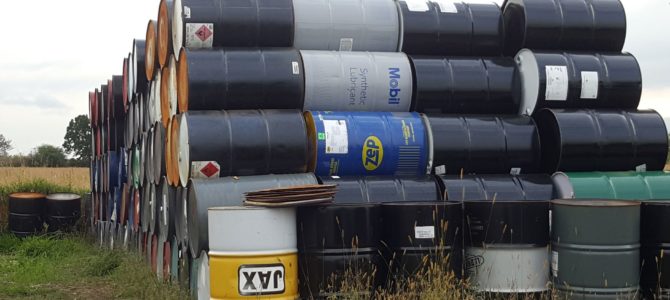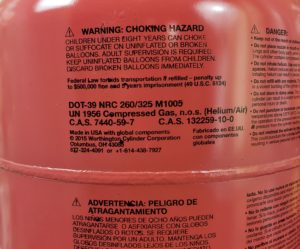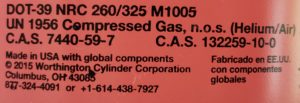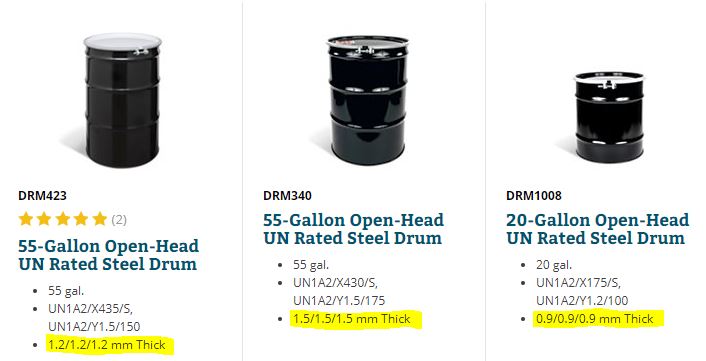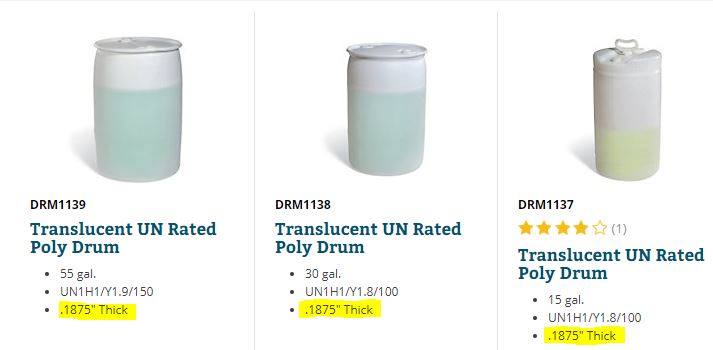Introduction:
In my experience most shippers of a hazardous material (HazMat) will use a packaging only once. After that initial use the packaging is either disposed of, recycled, or sent for reconditioning. All of these options are subject to USEPA, USDOT/PHMSA, and possibly state regulations. Many HazMat shippers are unaware of the allowance to reuse a packaging for the transport in commerce of a hazardous material; perhaps many times. This allowance of the Hazardous Materials Regulations (HMR) of USDOT/PHMSA will not only result in less waste generation but will also save you money.
The purpose of this article is to identify and explain the USDOT/PHMSA regulations at 49 CFR 173.28(a,b, & e) for the reuse of a packaging for the transport of a hazardous material.
Scope and Applicability:
The scope and applicability of these regulations are limited to the following:
- Transport must be “in commerce”. i.e., by or for a business or government agency engaged in commercial activity.
- Packaging must be used for the transport of a hazardous material (HazMat). Non-HazMat are not subject to these regulations.
- Non-bulk packaging only. Bulk packagings may be reused but are subject to different regulations dependent on their packaging type. The reuse of bulk packagings will not be considered in this article.
- MADE IN THE USA: “The reuse provisions only apply to UN performance-oriented or specification packagings manufactured and filled in the United States.” (01-0270)
- Not limited to original user: “There is no limitation on who may reuse a packaging for the transportation of hazardous materials. The person who reuses the packaging does not have to be the original user.” (99-0125)
|
Contact me with any questions you may have about the transportation of hazardous materials by air, highway, vessel, or rail International and Domestic Daniels Training Services, Inc. 815.821.1550 |
Before we begin…
- §173.28(c) addresses the requirements for the reconditioning of non-bulk packagings. The reconditioning of non-bulk packagings will not be addressed in this article.
- §173.28(d) addresses the remanufacture of non-bulk packagings. The remanufacture of a non-bulk packaging will not be addressed in this article.
- The reuse of a packaging for a Division 6.2 Infectious Substance is described in §173.28(f) and will not be addressed in this article.
- The reuse of a packaging may require its transport while it contains the residue of a hazardous material. This type of transport is subject to the HMR. Read: USDOT Requirements for the Transport of Empty HazMat Packagings
General Conditions for Reuse:
Before reuse each packaging – even a non-reusable container – must be inspected. The purpose of the inspection is to ensure that all packagings and receptacles to be reused are in a condition that complies with all of the requirements of the HMR; this includes closure devices and cushioning materials. This requires compliance with the HMR’s general packaging requirements:
- §173.24 – General requirements for packagings and packages
- §173.24(a)(2) indicates the regulations apply to both new packagings and packagings to be reused.
- §173.24a – Additional general requirements for non-bulk packagings and packages
But that’s not all. The inspection must also determine the non-bulk packaging to be reused is capable of passing all performance tests represented by the packaging markings (11-0085). These are found at §178, subpart M.
A packaging may not be reused under any of the following conditions:
- Contains a residue that is incompatible with the HazMat it is to be refilled. Note: This does not mean free from any residue. Just free from any incompatible residue.
- Has been ruptured.
- Displays evidence of other damage which reduces its structural integrity. Note: The key term here is, “…reduces its structural integrity.” The person reusing the packaging must determine if damage – if any is observed – is sufficient to reduce the packagings structural integrity.
A non-bulk packaging that shows evidence of a reduction in integrity may not be reused unless it is reconditioned per §173.28(c).
Q: What is the definition of “other damage”? Does the shipper have the authority to determine when “other damage” has occurred to one of its packagings?
A: The HMR do not provide a definition for “other damage” beyond that provided in §173.28(a), i.e., “damage which reduces [the packagings’] structural integrity.” The shipper is responsible for identifying packaging deficiencies that may reduce the packagings structural integrity. (o4-0101)
That may seem like a lot. But really, the general conditions for reuse of a packaging aren’t any different than the responsibilities of the shipper prior to the first use of a non-bulk packaging.
Conditions for Reuse of Specific Packaging Types:
Packagings made of paper (other than fiberboard), plastic film, or textile:
Per §173.28(b)(3), packagings made of the following materials may not be reused:
- Paper (other than fiberboard).
- Plastic film.
- Textile
Packagings made of fiberboard (box or drum) may be reused. A challenge specific to this type of packaging is damage that may be caused by removal of tape used for closure. Tears to the facing / laminate of the fiberboard may result in a reduction in structural integrity of the packaging which will render the packaging unfit for reuse. For this type of packaging, cutting the tape, leaving it attached to the packaging, and then taping over the old tape may be a better option than removing the old tape entirely. (04-0101, 06-0019)
|
Contact me with any questions you may have about the generation, identification, management, and disposal of hazardous waste Daniels Training Services, Inc. 815.821.1550 |
Previously used non-bulk packaging reused for the shipment of hazardous waste:
§173.28(b)(6) allows a previously used non-bulk packaging to be reused for the shipment of hazardous waste, not subject to the regulations of §173.28 if done in compliance with §173.12(c).
Non-reusable containers (NRC):
The definition of the term at §171.8 refers back to §173.28:
NRC (non-reusable container) means a packaging (container) whose reuse is restricted in accordance with the provisions of §173.28 of this subchapter.
Per §173.28(e) a packaging marked as NRC according to the DOT specification or UN standard requirements of 49 CFR part 178 may only be reused for the transport of a HazMat that does not require a DOT specification or UN standard packaging.
Q: What is an example of a HazMat that does not require a DOT specification or UN standard packaging?
A: Any hazardous material subject to one of the following packaging exceptions:
- Limited quantity
- Small quantity
- Excepted quantity
- De Minimis
- Lithium battery subject to §173.185(c)
- And other exceptions in the HMR…
This means, however, that a packaging marked as NRC according to the DOT specification or UN standard requirements of 49 CFR part 178 may not be used for the transport in commerce of a hazardous material unless it is subject to one of the above-referenced packaging exceptions. If used, the packaging still must meet the general conditions for reuse identified earlier in this article (11-0085).
The inclusion of text, “…a packaging marked as NRC according to the DOT specification or UN standard requirements of 49 CFR part 178…” (emphasis added) may seem unnecessary until you learn that a packaging might be marked with “NRC” for an entirely different reason than its reuse: i.e., it is a packaging approved by the Nuclear Regulatory Commission (NRC). §172.203(d)(7) and §173.471 refer to the display of “NRC” as a packaging mark because it is approved by the Nuclear Regulatory Commission.
Prior to 1991, the letters “STC” (single trip container) and “NRC” (nonreusable container) were used as markings on certain, now obsolete, DOT specification non-bulk packagings that restricted the use of those packagings. Currently, the only packaging required to have an NRC marking is the DOT 39 cylinder at §178.65(i).
Q: What options for reuse do I have for a packaging marked by the manufacturer as NRC according to the DOT specification or UN standard requirements of 49 CFR Part 178?
A: Not much. The packaging may only be used for a hazardous material that does not require DOT specification or UN standard packaging, a non-hazardous material, or the shipper may request a special permit from USDOT/PHMSA that allows for its reuse.
|
Like this article? Subscribe to my Monthly Newsletter No marketing emails! |
Plastic inner receptacles of composite packagings:
Plastic inner receptacles of composite packagings must have a minimum thickness of 1.0 mm (0.039 inch).
Metal and plastic drums and jerricans used as single packagings or the outer packagings of composite packagings:
First of all, let’s make sure we’re clear on the type of packagings subject to this regulation at §173.28(b)(4). Two types of packagings are identified, both are defined at §171.8:
- “Single packaging means a non-bulk packaging other than a combination packaging.” Single packagings subject to this regulation include:
- Steel drum (1A1 or 1A2)
- Aluminum drum (1B1 or 1B2)
- Metal drum (1N1 or 1N2)
- Steel jerrican (3A1 or 3A2)
- Aluminum jerrican (3B1 or 3B2)
- Plastic drum (1H1 or 1H2)
- Plastic jerrican (3H1 or 3H2)
- “Composite packaging means a packaging consisting of an outer packaging and an inner receptacle, so constructed that the inner receptacle and the outer packaging form an integral packaging. Once assembled it remains thereafter an integrated single unit; it is filled, stored, shipped and emptied as such.” Though composite packagings are many, only the following are subject to this regulation:
- Plastic receptacle within a protective steel drum (6HA1)
- Plastic receptacle within a protective aluminum drum (6HB1)
- Plastic receptacle within a protective plastic drum (6HH1)
- Glass, porcelain, or stoneware receptacles within a protective steel drum (6PA1)
- Glass, porcelain, or stoneware receptacles within a protective aluminum drum (6PB1)
- These regulations do not apply to any of the above packagings if they are the outer packaging of a combination packaging (14-0136).
To be authorized for reuse, the above packagings must be marked in a permanent manner (e.g., embossed) as follows:
- The nominal thickness of the packaging material in mm for metal packagings.
- The minimum thickness of the packaging material in mm for plastic packagings.
For a full description of the required marking refer to §178.503(a)(9).
But we’re not done. To be eligible for reuse the packaging must conform to the following minimum thickness criteria (an exception to these criteria for packagings manufactured before January 1, 1997 is identified after the table):
| Maximum capacity not over | Minimum thickness of packaging material | |
|---|---|---|
| Metal drum or jerrican | Plastic drum or jerrican | |
| 20 L | 0.63 mm (0.025 inch) | 1.1 mm (0.043 inch) |
| 30 L | 0.73 mm (0.029 inch) | 1.1 mm (0.043 inch) |
| 40 L | 0.73 mm (0.029 inch) | 1.8 mm (0.071 inch) |
| 60 L | 0.92 mm (0.036 inch) | 1.8 mm (0.071 inch) |
| 120 L | 0.92 mm (0.036 inch) | 2.2 mm (0.087 inch) |
| 220 L | 0.92 mm (0.036 inch)1 | 2.2 mm (0.087 inch) |
| 450 L | 1.77 mm (0.070 inch) | 5.0 mm (0.197 inch) |
1 Metal drums or jerricans manufactured and marked before January 1, 1997 with a minimum thickness of 0.82 mm body and 1.09 mm heads may be reused. Those packagings manufactured and marked after January 1, 1997 and intended for reuse must be constructed with a minimum thickness of 0.82 mm body and 1.11 mm heads.
Stainless steel drums and jerricans are not subject to the requirements of the above table. They must conform to a minimum wall thickness as determined by the following equivalence formula:
FORMULA FOR METRIC UNITS
FORMULA FOR U.S. STANDARD UNITS
Symbols in the above formulas have the following values:
- e1 = required equivalent wall thickness of the metal to be used (in mm or, for U.S. Standard units, use inches).
- e0 = required minimum wall thickness for the reference steel (in mm or, for U.S. Standard units, use inches).
- Rm1 = guaranteed minimum tensile strength of the metal to be used (in N/mm2 or for U.S. Standard units, use psi).
- A1 = guaranteed minimum elongation (as a percentage) of the metal to be used on fracture under tensile stress (see paragraph (c)(1) of this section).
How important is this requirement? Well, §173.28(a) includes as a general condition that a packaging not meeting the minimum thickness requirements may not be reused or reconditioned for reuse.
Q: Does that mean I must measure the minimum / nominal thickness of this packaging type before each reuse?
A: No. What you must do is ensure the packaging is permanently marked with its minimum / nominal thickness and that the marked thickness meets the minimum thickness criteria either of the table or the equivalence formula, as applicable.
Q: If a packaging was not marked by the manufacturer with the minimum / nominal thickness at the time of manufacture, may it be marked at a later date by the reuser or reconditioner of the packaging?
A: Yes. A packaging not marked at the time of manufacture with the minimum / nominal thickness may be permanently marked at a later date by the reuser or reconditioner provided the integrity of the packaging is not degraded and the packaging was initially intended to be reused. (00-0227)
|
If you like this article, please share it using any of the social media platforms identified at the bottom of this article. You’ll look real smart recommending my articles! |
Packagings subject to the leakproofness test with air:
§173.28(b)(2) specifies the requirements for the leakproofness test prescribed at §178.604 for certain packagings to be reused. §173.28(b)(7) identifies conditions where a packaging subject to the leakproofness test may not be required to be tested.
Before we go any further, what packagings are subject to the leakproofness test with air prescribed in §178.604? Quite simply: all packagings intended to contain liquids, except that:
- The inner receptacle of a composite packaging may be tested without the outer packaging if the test results are not affected.
- The test is not required for inner packagings of combination packagings.
The leakproofness test is not required for any packaging intended for the transport of solid HazMat.
Q: Is the leakproofness test required for packagings intended for reconditioning or remanufacture?
A: Yes, though not clearly stated in §173.28(c) for reconditioning or §173.28(d) for remanufacture. The determination is made as follows:
- §173.28(c)(3) requires a reconditioned packaging to be marked as indicated at §178.503(c) & (d). Per §178.503(c)(1)(v), every reconditioned packaging that passed a leakproofness test must be marked with an “L”.
- §173.28(d) states a remanufacturer of a packaging is subject to the requirements of part 178 as a manufacturer. A packaging manufacturer must ensure each packaging is capable of passing the prescribed tests, which includes the leakproofness test at §178.604.
§173.28(b)(2) requires the following for packagings subject to the leakproofness test prior to reuse:
- Retest without failure per §178.604 Leakproofness test using an internal air pressure (gauge) of at least:
- 48 kPa (7.0 psig) for Packing Group I. Note: this is higher than the minimum air pressure required at §178.604(e)(1) for Packing Group I.
- 20 kPa (3.0 psig) for Packing Group II. Note: this is the same as §178.604(e)(2) for Packing Group II.
- 20 kPa (3.0 psig) for Packing Group III. Note: this is the same as §178.604(e)(3) for Packing Group III.
- The packaging that is retested without failure per above must then be marked:
- With the letter “L”.
- Name and address or symbol of the person conducting the test.
- Last two digits of the year the test was conducted.
- Symbols, if used must be registered with the Associate Administrator (aka: USDOT/PHMSA).
However, §173.28(b)(7) allows for the reuse of a packaging without the leakproofness test if the packaging complies with the following:
Reuse of a packaging subject to the leakproofness test without performing the leakproofness test:
A packaging subject to the leakproofness test at §173.28(b)(2) may be authorized for reuse without performing the leakproofness test if the packaging complies with all of the following requirements of §173.28(b)(7):
- Is otherwise authorized for use according to the requirements of §173.28.
- Is refilled with a HazMat compatible with the previous contents. Note: this does not require the same HazMat, merely one that is compatible with what was in the packaging previously.
- Is refilled and offered for transport by the original filler. Note: this does not specify who performs the transport, merely who fills and “offers for transport” (aka: the shipper).
- Is transported in a transport vehicle or freight container under the exclusive use of the refiller of the packaging.
- “Exclusive use” means that the transport vehicle does not contain any material offered by anyone other than the filler of the packaging (04-0111).
- Is constructed of one of the following:
- Stainless steel, monel, or nickel with a thickness not less than 1 1/2 times the minimum thickness prescribed in §173.28(b)(4), (see above in this article).
- Plastic, if it is not refilled for reuse more than five (5) years from its date of manufacture. The month and year of a plastic packaging’s manufacture is marked on the packaging pursuant to §178.503(a)(6).
- Another material or thickness when approved under the conditions established by the Associate Administrator (aka: USDOT/PHMSA) for reuse without retesting.
Q: Does this mean that a plastic packaging has a five year limit on its use for the transport of a HazMat?
A: No. A plastic packaging may continue to be reused pursuant to §173.28 even after five (5) years. However, after five (5) years from its date of manufacture it is no longer eligible for this exception and must be leakproofness tested before reuse.
Don’t confuse this limit for the reuse of plastic packaging under §173.28 with a similar but more restrictive limit on the use of plastic packagings in the dangerous goods regulations of the International Air Transport Association (IATA) and the International Maritime Organization (IMO). Under their regulations (5.0.2.1.5 for IATA and 4.1.1.15 for IMO) a plastic packaging may not be used or reused more than five (5) years after its date of manufacture. USDOT/PHMSA has no such limitation (17-0031).
|
Daniels Training Services, Inc. 815.821.1550 |
Conclusion:
Whew! After all that you might be thinking the reuse of a HazMat packaging is not worth the trouble of compliance, but hold on. Let’s summarize the requirements:
- Perform an inspection of the packaging to ensure in good condition for reuse.
- No incompatible residue.
- If the packaging is designed for liquid HazMat, perform the leakproofness test. No leakproofness test for solid HazMat.
- The leakproofness test may not be required if the packaging is refilled and shipped by the original filler, is transported in a vehicle under the exclusive use of the refiller, and the packaging is made of stainless steel, monel, or nickel of the prescribed thickness or plastic and not more than five (5) years old.
And…
- Metal and plastic drums and jerricans used as single packagings or the outer packaging of composite packagings must be permanently marked to indicate they meet the minimum thickness requirements.
And remember, “There is no limitation on who may reuse a packaging for the transportation of hazardous materials. The person who reuses the packaging does not have to be the original user.” (99-0125)
